Key Factors Affecting the Initial Regeneration Following Forest Fires
Abstract
1. Introduction
2. Materials and Methods
2.1. Study Regions
2.2. Field Survey
2.3. Postfire Initial Regeneration
2.4. Data Analysis
3. Results
3.1. Regeneration Coverage of Initial Stands
3.2. Fire-, Site- and Prefire Forest Factors
3.3. Effects of Fire, Site, and Prefire Forest Factors on the Regeneration Coverage of Initial Stands: Random Forest Analysis
3.4. Partial-Dependence of Ten Variables on the Regeneration Coverage of Initial Stands
4. Discussion
5. Conclusions
Supplementary Materials
Author Contributions
Funding
Data Availability Statement
Acknowledgments
Conflicts of Interest
References
- Barton, A.M. Gradient analysis of relationships among fire, environment, and vegetation in a southwestern USA mountain range. Bull. Torrey. Bot. Club. 1994, 121, 251–265. [Google Scholar] [CrossRef]
- Lentile, L.B.; Morgan, P.; Hudak, A.T.; Bobbitt, M.J.; Lewis, S.A.; Smith, A.M.S.; Robichaud, P.R. Post-fire burn severity and vegetation response following eight large wildfires across the western United States. Fire Ecol. 2007, 3, 91–108. [Google Scholar] [CrossRef]
- Shin, Y. Natural Regeneration of Forests with Different Burn Severity and Initial Regeneration Following Forest Fire in the East Coast Region, Korea. Ph.D. Thesis, Kangwon National University, Chuncheon, Korea, 2015. (In Korean). [Google Scholar]
- Mun, H.; Choung, Y. Effects of forest fire on soil properties in pine forests in Kosong. Korea. J. Ecol. 1996, 19, 375–383. (In Korean) [Google Scholar]
- Lee, W.K.; Kim, C.; Cha, S.H.; Kim, Y.K.; Byun, J.K.; Koo, K.S.; Park, J.W. Fire effects on soil physical and chemical properties following the forest fire in Kosung. Korea. J. Ecol. 1997, 20, 157–162. (In Korean) [Google Scholar]
- Kim, W.; Park, J.; Cho, Y. Effects of fire on forest vegetation in Mt. Samma. Korea. Korean J. Ecol. 1999, 22, 145–153. (In Korean) [Google Scholar]
- Whelan, R.J. The Ecology of Fire; Cambridge University Press: Cambridge, UK, 1995. [Google Scholar]
- Agee, J.K. Fire Ecology of Pacific Northwest Forests; Island Press: Washington, DC, USA, 1993. [Google Scholar]
- Moghaddas, J.J.; York, R.A.; Stephens, S.L. Initial response of conifer and California black oak seedlings following fuel reduction activities in a Sierra Nevada mixed conifer forest. For. Ecol. Manag. 2008, 255, 3141–3150. [Google Scholar] [CrossRef]
- Broncano, M.J.; Retana, J. Topography and forest composition affecting the variability in fire severity and post-fire regeneration occurring after a large fire in the Mediterranean basin. Int. J. Wildland Fire 2004, 13, 209–216. [Google Scholar] [CrossRef]
- Han, J.; Shen, Z.; Ying, L.; Li, G.; Chen, A. Early post-fire regeneration of a fire-prone subtropical mixed Yunnan pine forest in Southwest China: Effects of pre-fire vegetation, fire severity and topographic factors. For. Ecol. Manag. 2015, 356, 31–40. [Google Scholar] [CrossRef]
- Bassett, M.; Leonard, S.W.; Chia, E.K.; Clarke, M.F.; Bennett, A.F. Interacting effects of fire severity, time since fire and topography on vegetation structure after wildfire. For. Ecol. Manag. 2017, 396, 26–34. [Google Scholar] [CrossRef]
- Takaoka, S.; Sasa, K. Landform effects on fire behavior and post fire regeneration in the mixed forests of northern Japan. Ecol. Res. 1996, 11, 339–349. [Google Scholar] [CrossRef]
- Barbour, M.G.; Burk, J.H.; Pitts, W.D.; Gilliam, F.S.; Schwartz, M.W. Terrestrial Plant Ecology, 3rd ed.; Benjamin Cummings: Menlo Park, CA, USA, 1999. [Google Scholar]
- Pausas, J.G.; Ribeiro, E.; Vallejo, R.V. Post-Fire regeneration variability of Pinus halepensis in the eastern Iberian Peninsula. For. Ecol. Manag. 2004, 203, 251–259. [Google Scholar] [CrossRef]
- Boiffin, J.; Munson, A.D. Three large fire years threaten resilience of closed crown black spruce forests in eastern Canada. Ecosphere 2013, 4, 56. [Google Scholar] [CrossRef]
- Harvey, B.J.; Donato, D.C.; Turner, M.C. High and dry: Post-fire tree seedling establishment in subalpine forests decreases with post-fire drought and large stand-replacing burn patches. Global Ecol. Biogeogr. 2016, 25, 655–669. [Google Scholar] [CrossRef]
- Clark, J.S. Disturbance and tree life history on the shifting mosaic landscape. Ecology 1991, 72, 1102–1118. [Google Scholar] [CrossRef]
- Bond, W.J.; Midgley, J.J. Ecology of sprouting in woody plants: The persistence niche. Trends Ecol. Evol. 2001, 16, 45–51. [Google Scholar] [CrossRef]
- Dietze, M.C.; Clarke, J.S. Changing the gap dynamics paradigm: Vegetative regeneration control on forest response to disturbance. Ecol. Monograph. 2008, 78, 331–347. [Google Scholar] [CrossRef]
- Kozlowski, T.T.; Kramer, P.J.; Pallardy, S.G. The Physiological Ecology of Woody Plants; Academic Press: Cambridge, MA, USA, 2012. [Google Scholar]
- Masaka, K.; Ohno, Y.; Yamada, K. Fire tolerance and the fire-related sprouting characteristics of two cool-temperate broad-leaved tree species. Ann. Bot. 2000, 85, 137–142. [Google Scholar] [CrossRef]
- Bellingham, P.J.; Tanner, E.V.J.; Healey, J.R. Sprouting of trees in jamaican montane forests, after a hurricane. J. Ecol. 1994, 8, 747–758. [Google Scholar] [CrossRef]
- Bellingham, P.J.; Sparrow, A.D. Resprouting as a life history strategy in woody plant communities. Oikos 2000, 89, 409–416. [Google Scholar] [CrossRef]
- Bond, W.J.; Midgley, J.J. The evolutionary ecology of sprouting in woody plants. Int. J. Plant Sci. 2003, 164, S103–S114. [Google Scholar] [CrossRef]
- Vesk, P.A.; Westoby, M. Sprouting ability across diverse disturbances and vegetation types worldwide. J. Ecol. 2004, 92, 310–320. [Google Scholar] [CrossRef]
- Clarke, P.J.; Lawes, M.J.; Midgley, J.J.; Lamont, B.B.; Ojeda, F.; Burrows, G.E.; Enright, N.J.; Knox, K.J.E. Resprouting as a key functional trait: How buds, protection and resources drive persistence after fire. New Phytol. 2013, 197, 19–35. [Google Scholar] [CrossRef] [PubMed]
- Noh, D.; Gong, J.; Lee, S.; Kim, C.; Kim, J.; Seo, S.; Paek, J.; Kim, S.; Sim, W.; Son, Y.; et al. Damage of forests in the East Coast Fire. In Report of the East Coast Fires in 2000 (I); The Joint Association for the Investigation of the East Coast Fires: Seoul, Korea, 2000; pp. 27–49. (In Korean) [Google Scholar]
- Choung, Y.; Lee, B.C.; Cho, J.H.; Lee, K.S.; Jang, I.S.; Kim, S.H.; Hong, S.K.; Jung, H.C.; Choung, H.L. Forest responses to the large-scale east coast fires in Korea. Ecol. Res. 2004, 19, 43–54. [Google Scholar] [CrossRef]
- Ilisson, T.; Chen, H.Y.H. Response of six boreal tree species to stand replacing fire and clearcutting. Ecosystems 2009, 12, 820–829. [Google Scholar] [CrossRef]
- Chen, H.Y.H.; Vasiliauskas, S.; Kayahara, G.J.; Ilisson, T. Wildfire promotes broadleaves and species mixture in boreal forest. For. Ecol. Manag. 2009, 257, 343–350. [Google Scholar] [CrossRef]
- Choung, Y.; Choung, M.S. Biodiversity of burned forests is controlled by the sprouting ability of prefire species in Pinus densiflora forests. Ecol. Eng. 2019, 127, 356–362. [Google Scholar] [CrossRef]
- Johnstone, J.F.; Chapin, F.S.; Foote, J.; Kemmett, S.; Price, K.; Viereck, L. Decadal observations of tree regeneration following fire in boreal forests. Can. J. For. Res. 2004, 34, 267–273. [Google Scholar] [CrossRef]
- Donato, D.C.; Cambell, J.L.; Franklin, J.F. Multiple successional pathways and precocity in forest development: Can some forests be born complex? J. Veg. Sci. 2012, 23, 576–584. [Google Scholar] [CrossRef]
- Choung, Y. Forest fires and vegetation responses in Korea. In Ecology of Korea; Lee, D., Jin, V., Choe, J.C., Son, Y., Yoo, S., Lee, H.Y., Hong, S.K., Ihm, B.S., Eds.; Bumwoo Publishing Co.: Paju, Korea, 2002; pp. 119–137. [Google Scholar]
- Seo, H.; Choung, Y. Vulnerability of Pinus densiflora to forest fire based on ignition characteristics. J. Ecol. Field Biol. 2010, 33, 343–349. [Google Scholar] [CrossRef]
- Seo, H.; Choung, Y. Enhanced vulnerability to fire by Pinus densiflora forests due to tree morphology and stand structure in Korea. J. Plant Biol. 2014, 57, 48–54. [Google Scholar] [CrossRef]
- Lee, S.Y.; Won, M.S.; Han, S.Y. Developing of forest fire occurrence danger index using fuel and topographical characteristics on the condition of ignition point in Korea. Fire Sci. Eng. 2005, 19, 75–79. (In Korean) [Google Scholar]
- National Institute of Agricultural Sciences. Available online: http://soil.rda.go.kr (accessed on 13 June 2022).
- Park, S.D.; Lee, K.S.; Shin, S.S. Statistical soil erosion model for burnt mountain areas in Korea—Rusle approach. J. Hydrol. Eng. 2012, 17, 292–304. [Google Scholar] [CrossRef]
- Shin, S.S.; Park, S.D.; Lee, K.S. Sediment and hydrological response to vegetation recovery following wildfire on hillslopes and the hollow of a small watershed. J. Hydrol. 2013, 499, 154–166. [Google Scholar] [CrossRef]
- Kim, Y.; Kim, C.G.; Lee, K.S.; Choung, Y. Effects of post-fire vegetation recovery on soil erosion in vulnerable montane regions in a monsoon climate: A decade of monitoring. J. Plant Biol. 2021, 64, 123–133. [Google Scholar] [CrossRef]
- Breiman, L. Random forests. Mach. Learn. 2001, 45, 5–32. [Google Scholar] [CrossRef]
- Prasad, A.M.; Iverson, L.R.; Liaw, A. Newer classification and regression tree techniques: Bagging and random forests for ecological prediction. Ecosystems 2006, 9, 181–199. [Google Scholar] [CrossRef]
- Cutler, D.R.; Edwards, J.T.C.; Beard, K.H.; Cutler, A.; Hess, K.T.; Gibson, J.; Lawler, J.J. Random forests for classification in ecology. Ecology 2007, 88, 2783–2792. [Google Scholar] [CrossRef]
- Larivière, B.; Van-den-Poel, D. Predicting customer retention and profitability by using random forests and regression forests techniques. Expert Syst. Appl. 2005, 29, 472–484. [Google Scholar] [CrossRef]
- Oliveira, S.; Oehler, F.; San-Miguel-Ayanz, J.; Camia, A.; Pereira, J.M.C. Modeling spatial patterns of fire occurrence in Mediterranean Europe using multiple regression and random forest. For. Ecol. Manag. 2012, 275, 117–129. [Google Scholar] [CrossRef]
- Korea Forest Service. Forest Fire Statistics 2004; Korea Forest Service: Daejeon, Korea, 2005. (In Korean) [Google Scholar]
- Korea Meteorological Agency. Available online: www.kma.go.kr (accessed on 13 June 2022).
- Jung, S. Dynamics of 20-Year Natural Regeneration of Canopy Tree Species in the Damaged Forests with Different Severity and Initial Regeneration. Master’s Thesis, Kangwon National University, Chuncheon, Korea, 2022. (In Korean). [Google Scholar]
- SPSS. IBM SPSS Statistics for Windows, Version 24.0; IBM Corp.: Armonk, NY, USA, 2016.
- Murphy, M.A.; Evans, J.S.; Storfer, A. Quantifying bufo boreas connectivity in Yellowstone National Park with landscape genetics. Ecology 2010, 91, 252–261. [Google Scholar] [CrossRef]
- R Core Team. R: A Language and Environment for Statistical Computing; R Foundation for Statistical Computing: Vienna, Austria, 2020. [Google Scholar]
- Liaw, A.; Wiener, M. Classification and regression by random forest. R News 2002, 2, 18–22. [Google Scholar]
- Abrahamson, W.G. Species responses to fire on the Florida lake wales ridge. Am. J. Bot. 1984, 71, 35–43. [Google Scholar] [CrossRef]
- Cirne, P.; Scarano, F.R. Resprouting and growth dynamics after fire of the clonal shrub Andira legalis (Leguminosae) in a sandy coastal plain in south-eastern Brazil. J. Ecol. 2001, 89, 351–357. [Google Scholar] [CrossRef]
- Goetz, S.J.; Fiske, G.J.; Bunn, A.G. Using satellite time-series data sets to analyze fire disturbance and forest recovery across Canada. Remote Sens. Environ. 2006, 101, 352–365. [Google Scholar] [CrossRef]
- Jones, M.O.; Kimball, J.S.; Jones, L.A. Satellite microwave detection of boreal forest recovery from the extreme 2004 wildfires in Alaska and Canada. Glob. Change Biol. 2013, 19, 3111–3122. [Google Scholar] [CrossRef]
- Ireland, G.; Petropoulos, G.P. Exploring the relationships between post-fire vegetation regeneration dynamics, topography and burn severity: A case study from the Montane cordillera ecozones of western Canada. Appl. Geogr. 2015, 56, 232–248. [Google Scholar] [CrossRef]
- Lee, J.M.; Lee, S.W.; Lim, J.H.; Won, M.S.; Lee, H.S. Effects of heterogeneity of pre-fire forests and vegetation burn severity on short-term post-fire vegetation density and regeneration in Samcheok, Korea. Landscape Ecol. Eng. 2014, 10, 215–228. [Google Scholar] [CrossRef]
- Fornwalt, P.J.; Kaufmann, M.R. Understorey plant community dynamics following a large, mixed severity wildfire in a Pinus ponderosa-Pseudotsuga menziesii forest, Colorado, USA. J. Veg. Sci. 2014, 25, 805–818. [Google Scholar] [CrossRef]
- Turner, M.G.; Romme, W.H.; Gardner, R.H.; Hargrove, W.W. Effects of fire size and pattern on early succession in Yellowstone National Park. Ecol. Monogr. 1997, 67, 411–433. [Google Scholar] [CrossRef]
- Schoennagel, T.; Turner, M.G.; Romme, W.H. The influence of fire interval and serotiny on postfire lodgepole pine density in Yellowstone National Park. Ecology 2003, 84, 2967–2978. [Google Scholar] [CrossRef]
- Gauthier, S.; Bergeron, Y.; Simon, J.P. Effects of fire regime on the serotiny level of Jack pine. J. Ecol. 1996, 84, 539–548. [Google Scholar] [CrossRef]
- Radeloff, V.C.; Mladenoff, D.J.; Guries, R.P.; Boyce, M.S. Spatial patterns of cone serotiny in Pinus banksiana in relation to fire disturbance. For. Ecol. Manag. 2004, 189, 133–141. [Google Scholar] [CrossRef]
- Hernández-Serrano, A.; Verdú, M.; González-Martínez, S.C.; Pausas, J.G. Fire structures pine serotiny at different scales. Am. J. Bot. 2013, 100, 2349–2356. [Google Scholar] [CrossRef] [PubMed]
- Hong, E. Establishment and Growth of Pinus Densiflora in Early Vegetative Regeneration Stage after Fire. Master’s Thesis, Kangwon National University, Chuncheon, Korea, 2004. (In Korean). [Google Scholar]
- Lee, K.S.; Choung, Y.; Kim, S.C.; Shin, S.S.; Ro, C.H.; Park, S.D. Development of vegetation structure after forest fire in the east coastal region, Korea. Korean J. Ecol. 2004, 27, 99–106. (In Korean) [Google Scholar] [CrossRef][Green Version]
- Kim, J.; Lim, J.H.; Shin, M.; Han, S.H.; Kang, W. Oak resprouting survival and competition for 19 years after wildfire in the Republic of Korea. Forests 2020, 11, 515. [Google Scholar] [CrossRef]
- Mansuy, N.; Gauthier, S.; Robitaille, A.; Bergeron, Y. Regional patterns of postfire canopy recovery in the northern boreal forest of Quebec: Interactions between surficial deposit, climate, and fire cycle. Can. J. For. Res. 2012, 42, 1328–1343. [Google Scholar] [CrossRef]
- Luo, Y.; Chen, H.Y.H. Observations from old forests underestimate climate change effects on tree mortality. Nat. Commun. 2013, 4, 1965. [Google Scholar] [CrossRef]
- Petrone, R.M.; Chasmer, L.; Hopkinson, C.; Silins, U.; Landhäusser, S.M.; Kljun, N.; Devito, K.J. Effects of harvesting and drought on CO2 and H2O fluxes in an aspen-dominated western boreal plain forest: Early chronosequence recovery. Can. J. For. Res. 2015, 45, 87–100. [Google Scholar] [CrossRef]
- Chazdon, R.L. Tropical forest recovery: Legacies of human impact and natural disturbances. Perspect Plant Ecol. Evol. Syst. 2003, 6, 51–71. [Google Scholar] [CrossRef]
- Bartels, S.F.; Chen, H.Y.H.; Wulder, M.A.; White, J.C. Trends in post-disturbance recovery rates of Canada’s forests following wildfire and harvest. For. Ecol. Manag. 2016, 361, 194–207. [Google Scholar] [CrossRef]
- Lee, J. Twenty-Year Natural Regeneration Process of Forest Structure and Plant Species Assembly in Burned Pinus Densiflora Forests. Master’s Thesis, Kangwon National University, Chuncheon, Korea, 2022. (In Korean). [Google Scholar]
- Kim, C.G.; Shin, K.; Joo, K.Y.; Lee, K.S.; Shin, S.S.; Choung, Y. Effects of soil conservation measures in a partially vegetated area after forest fires. Sci. Total Environ. 2008, 399, 158–164. [Google Scholar] [CrossRef] [PubMed]
- Kim, C.G.; Choung, Y.; Joo, K.Y.; Lee, K.S. Effects of hillslope treatments for vegetation development and soil conservation in burned forests. J. Ecol. Field Biol. 2006, 29, 295–303. (In Korean) [Google Scholar] [CrossRef][Green Version]
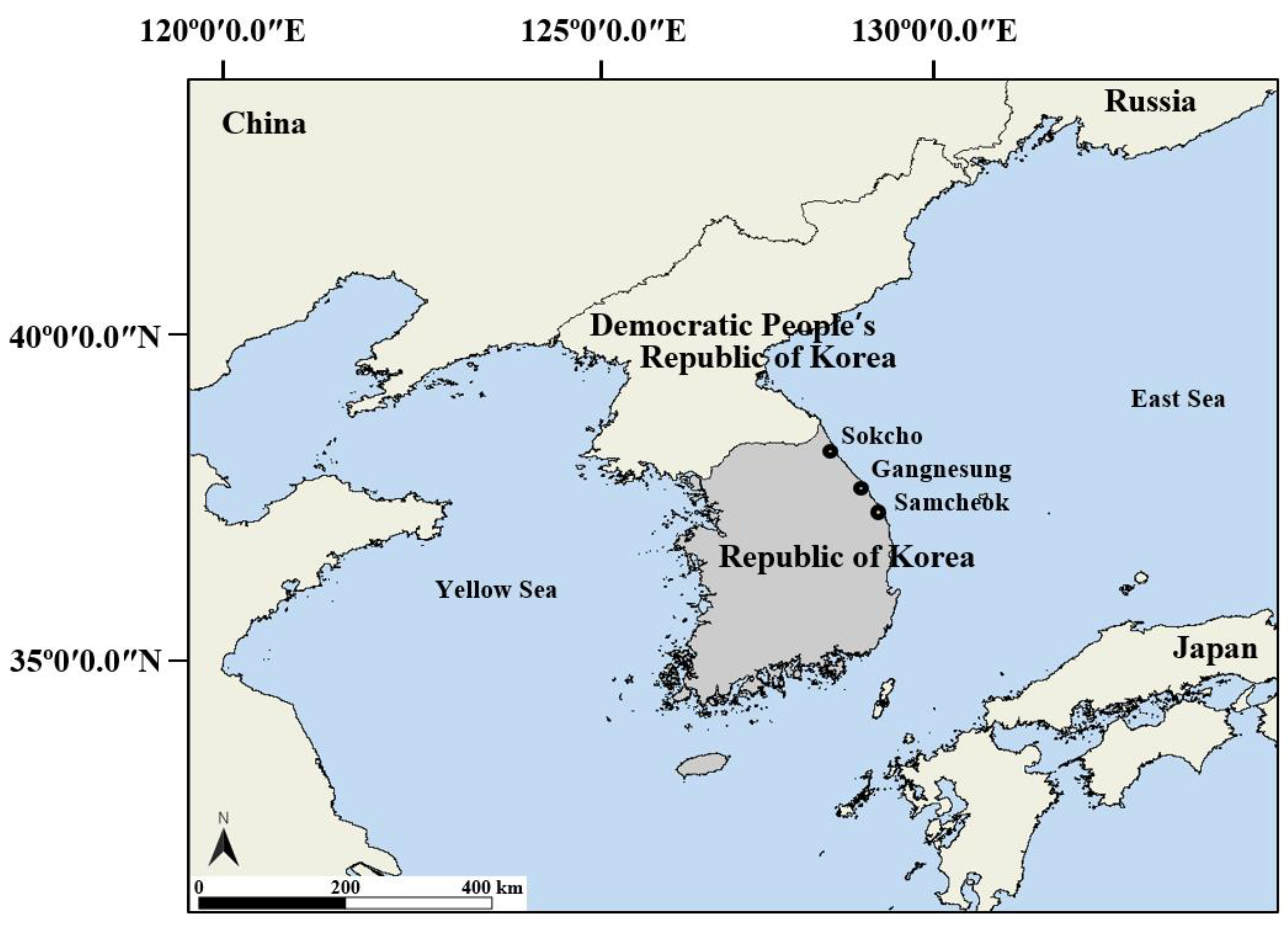
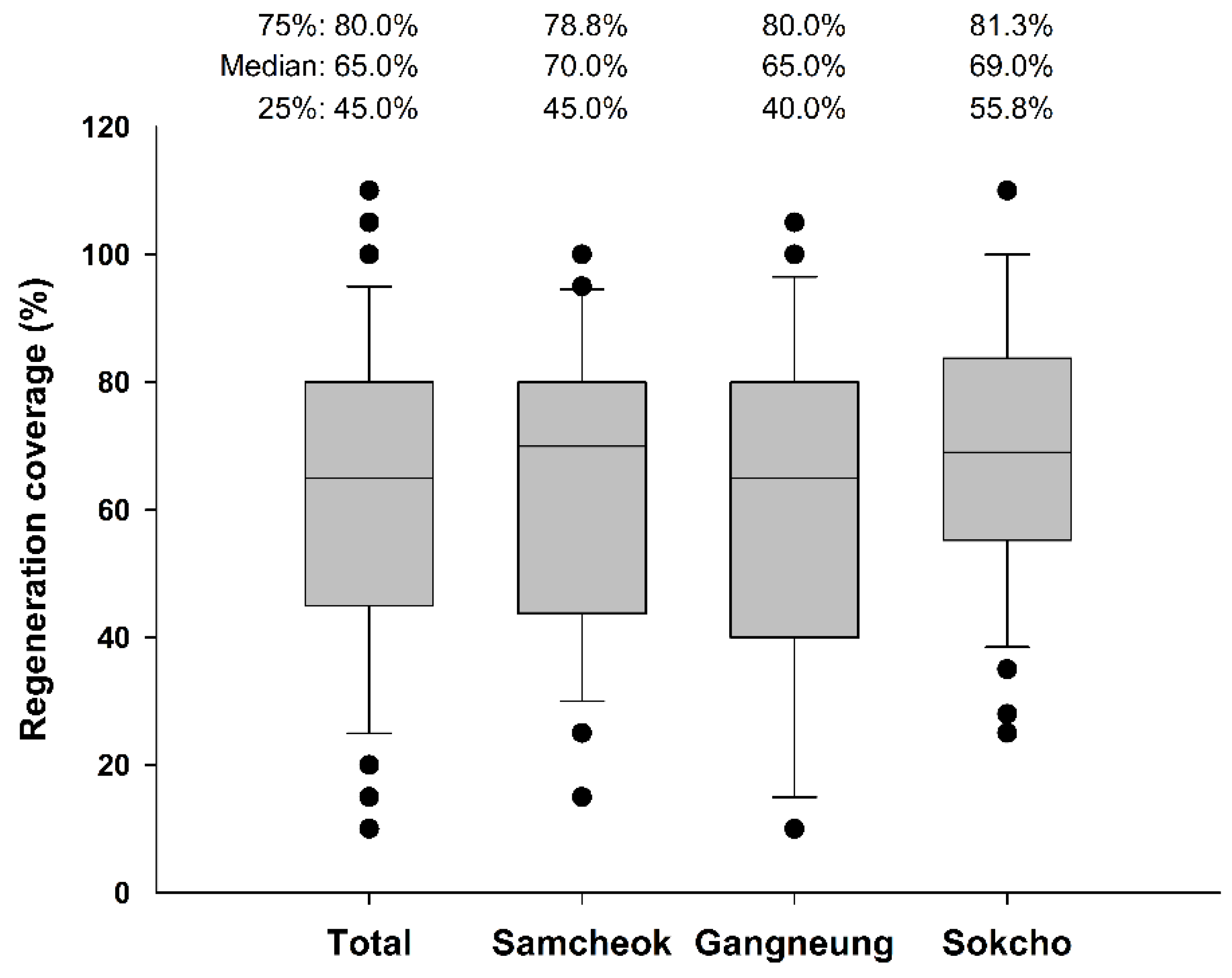

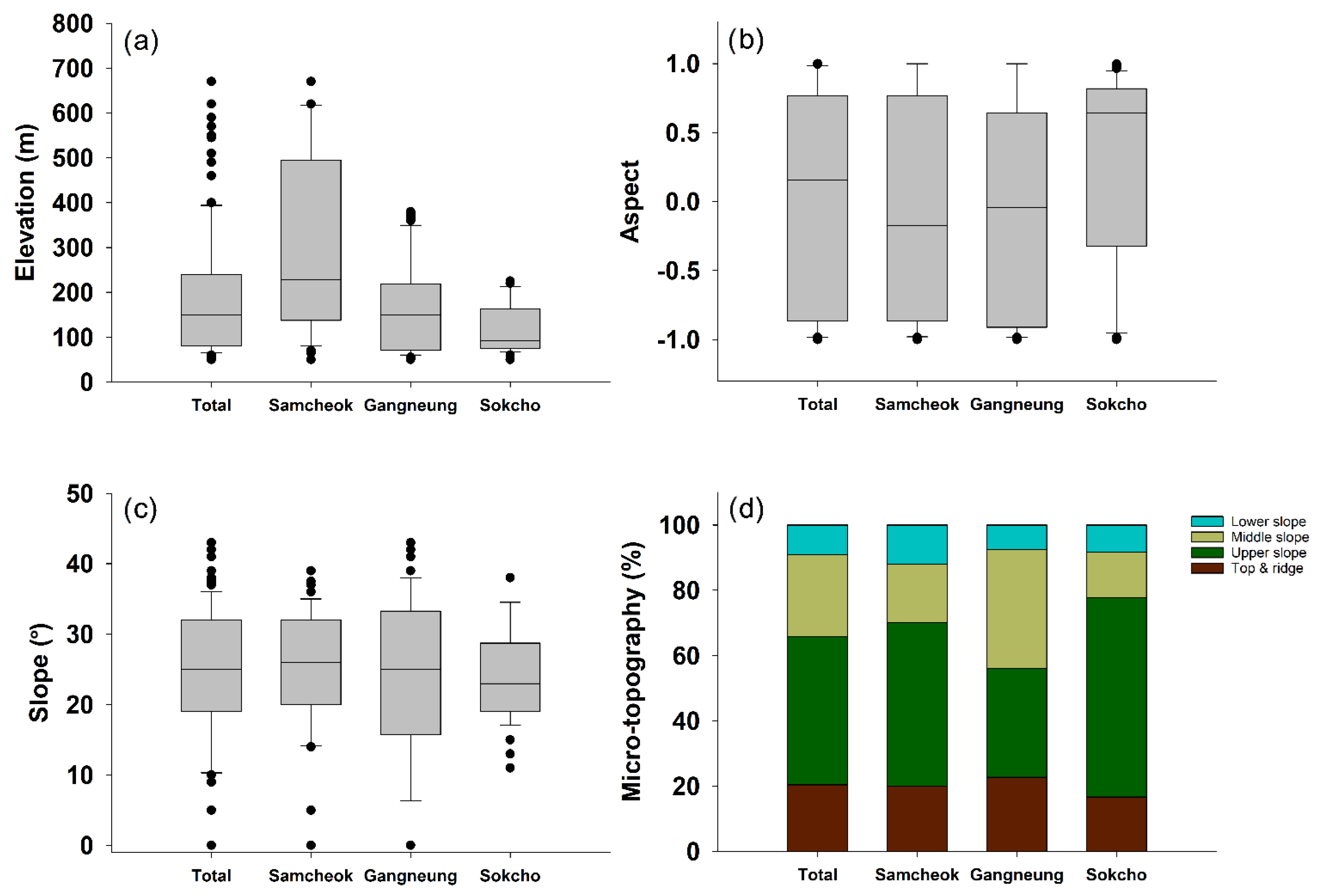
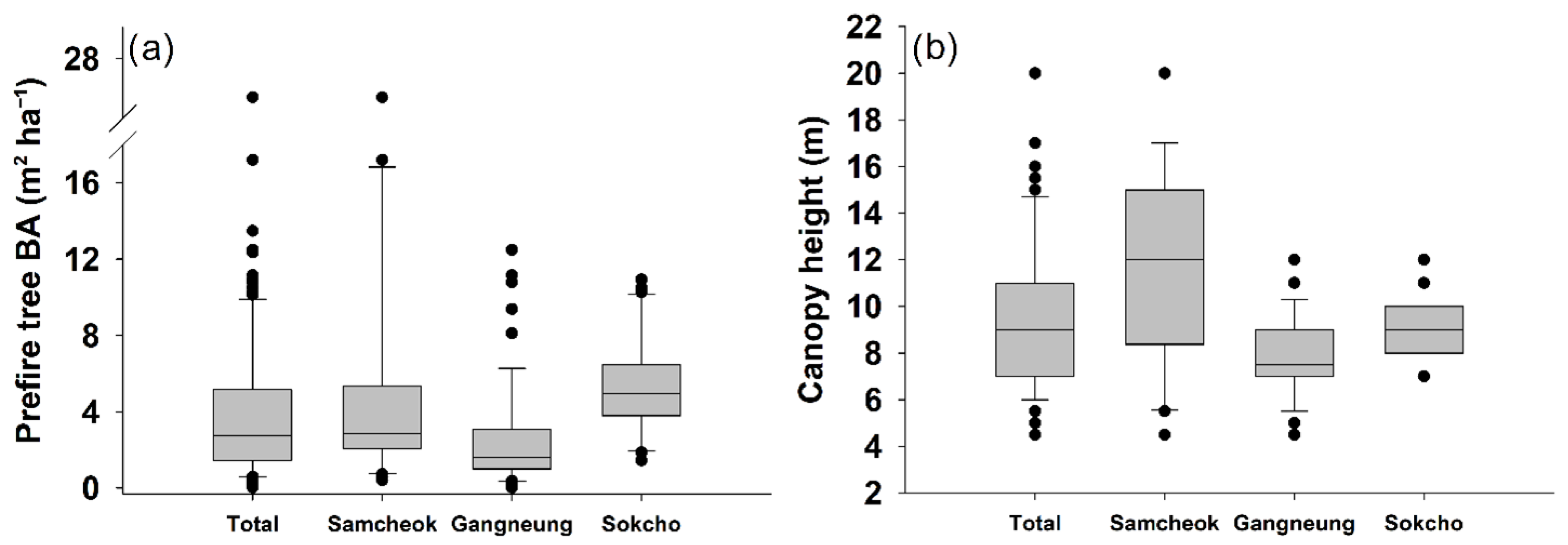
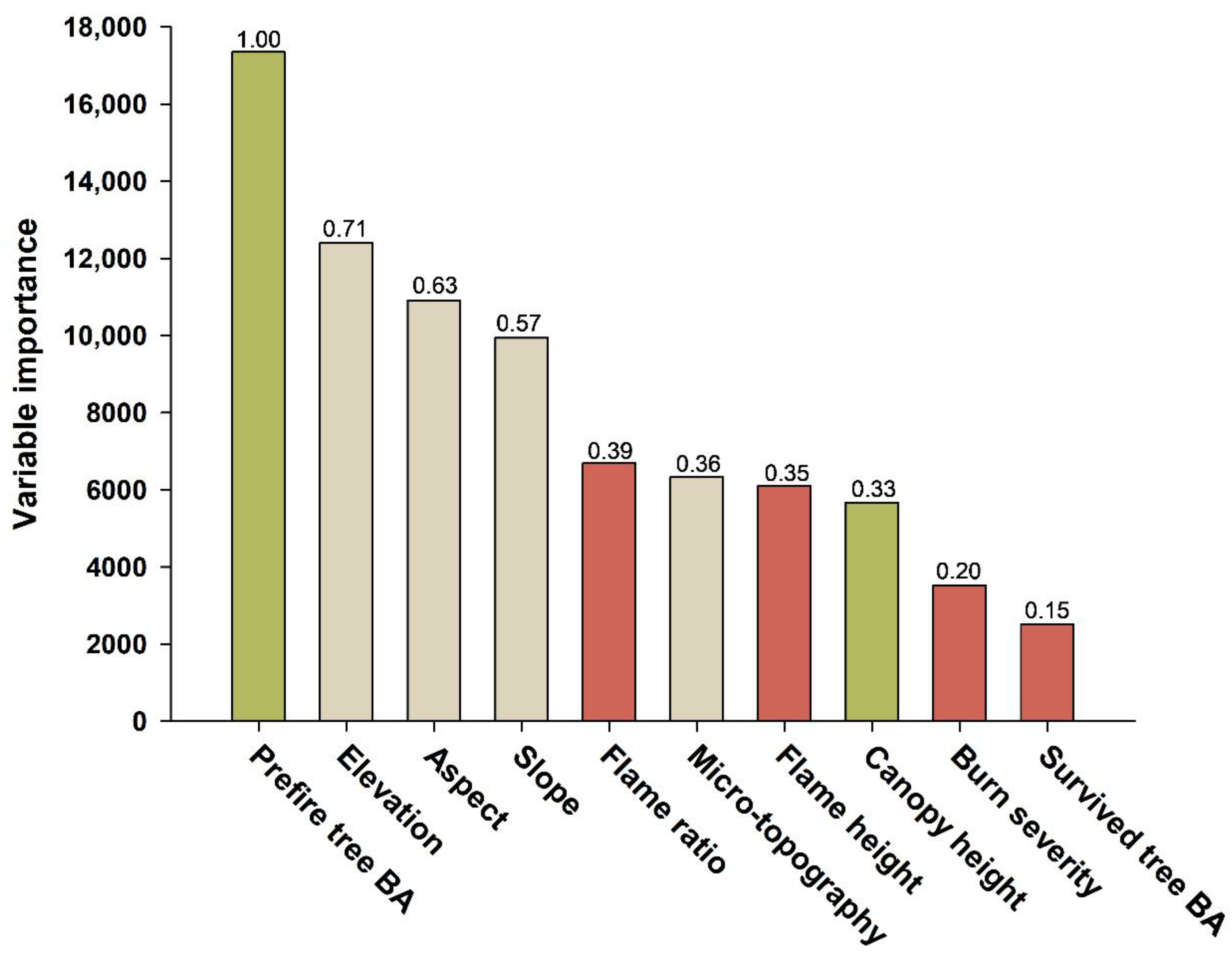
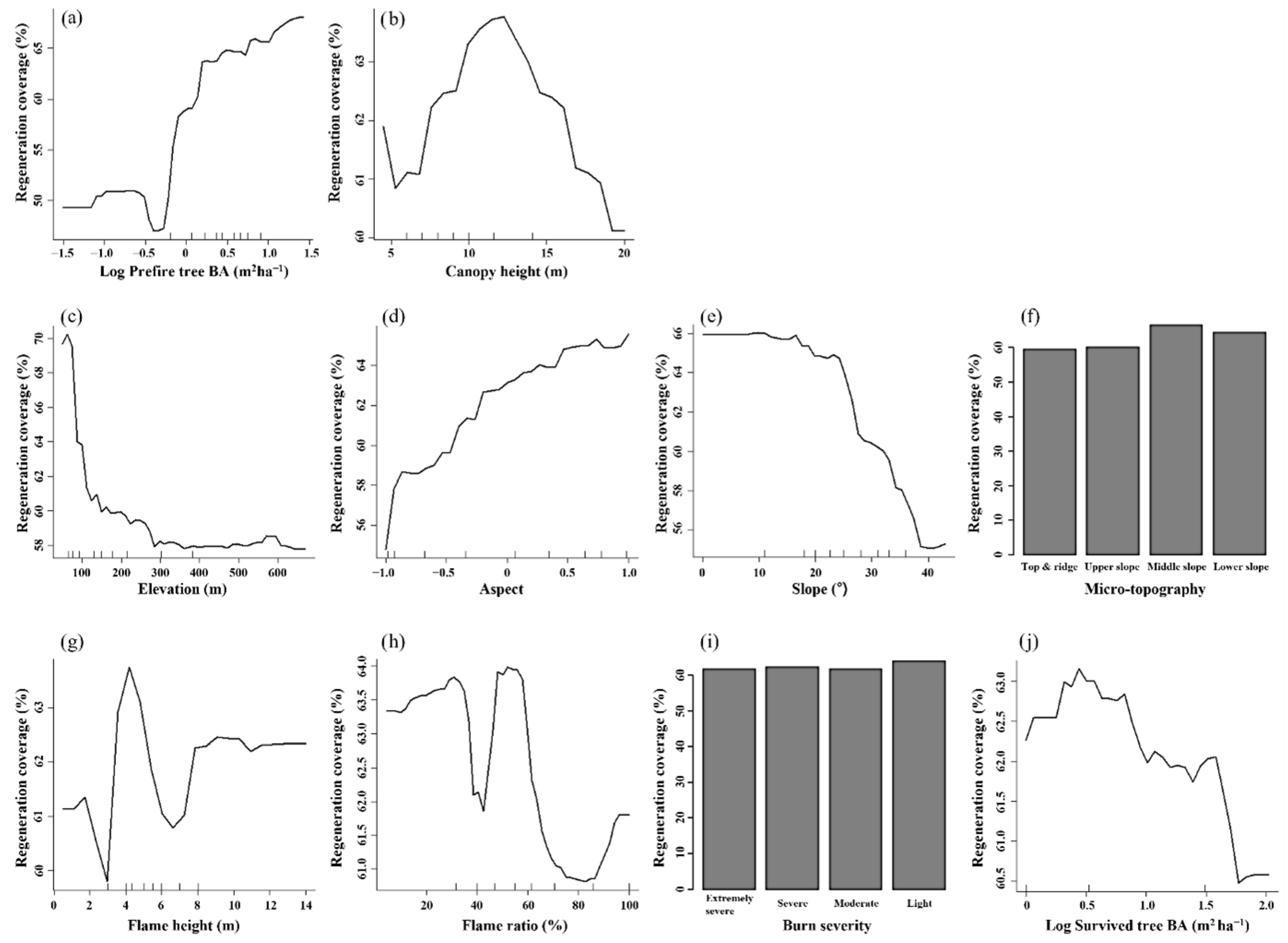
| Property | Samcheok | Gangneung | Sokcho |
|---|---|---|---|
| Fire | |||
| Fire occurrence | April, 2000 | March, 2004 | March, 2004 |
| Burned area (ha) | 23,794 | 430 | 200 |
| Climate | |||
| Annual mean temperature (°C) | 12.6 | 13.1 | 12.2 |
| Annual precipitation (mm) | 1119.0 | 1464.5 | 1402.2 |
| 1 Fire-season precipitation (mm) | 160.3 | 187.2 | 168.1 |
| Annual mean wind speed (m s−1) | 3.8 | 2.6 | 2.8 |
| 2 Fire-season wind speed (m s−1) | 4.2 | 2.9 | 3.2 |
| Soil | |||
| Parent rock | Metamorphic rock | Sedimentary rock | Acidic rock |
| Soil texture | Sandy loam, Loam | Silt loam | Sandy loam |
| 3 Prefire forest | |||
| 4 Basal area (m2 ha−1) | 35.9 ± 2.93 | 41.2 ± 2.46 | 29.7 ± 3.28 |
| Pinus densiflora | 31.7 ± 2.97 | 39.0 ± 2.53 | 27.7 ± 3.32 |
| Other trees | 4.1 ± 0.39 | 2.2 ± 0.23 | 2.0 ± 0.25 |
| 4 Canopy height | 11.8 ± 0.60 | 7.8 ± 0.21 | 8.9 ± 0.18 |
| 4 No. of stems ha−1 | 1128.0 ± 117.3 | 1093.9 ± 126.2 | 971.2 ± 91.5 |
| Pinus densiflora | 898.0 ± 110.5 | 957.4 ± 126.8 | 875.8 ± 91.6 |
| Other trees | 230.0 ± 15.3 | 136.5 ± 8.2 | 95.5 ± 6.0 |
| 5 Diameter (cm) | 12.2–16.0–21.3 | 12.5–15.7–20.7 | 17.2–21.3–26.0 |
| Pinus densiflora | 12.6–17.0–22.9 | 12.6–15.9–20.8 | 17.5–21.5–26.2 |
| Other trees | 11.8–13.0–17.8 | 11.0–13.5–17.9 | 11.1–12.0–14.3 |
| No. of plots | 50 | 66 | 36 |
Publisher’s Note: MDPI stays neutral with regard to jurisdictional claims in published maps and institutional affiliations. |
© 2022 by the authors. Licensee MDPI, Basel, Switzerland. This article is an open access article distributed under the terms and conditions of the Creative Commons Attribution (CC BY) license (https://creativecommons.org/licenses/by/4.0/).
Share and Cite
Lee, J.; Choung, Y. Key Factors Affecting the Initial Regeneration Following Forest Fires. Forests 2022, 13, 1859. https://doi.org/10.3390/f13111859
Lee J, Choung Y. Key Factors Affecting the Initial Regeneration Following Forest Fires. Forests. 2022; 13(11):1859. https://doi.org/10.3390/f13111859
Chicago/Turabian StyleLee, Jongsung, and Yeonsook Choung. 2022. "Key Factors Affecting the Initial Regeneration Following Forest Fires" Forests 13, no. 11: 1859. https://doi.org/10.3390/f13111859
APA StyleLee, J., & Choung, Y. (2022). Key Factors Affecting the Initial Regeneration Following Forest Fires. Forests, 13(11), 1859. https://doi.org/10.3390/f13111859






